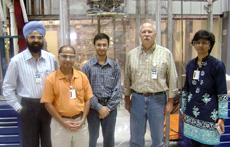From left: Rajeshwar Singh Sandha, RRCAT; Jishnu Dwivedi, RRCAT; Rohan Mittal, Devi Ahilya; Fermilab's Joe Ozelis and Archana Sharma, BARC.
Technical specifications and instructions help, but as Jishnu Dwivedi knows, building a superconducting radio frequency cavity requires more than a few thousand pages of text and diagrams.
"When you read from books, a lot of information does not directly apply to your project," said Dwivedi, a mechanical engineer visiting Fermilab from the Raja Ramanna Center for Advanced Technology in India. "By being here, we can see the components and get a good feel of the design, manufacturing and testing requirements."
In September, Dwivedi finished a three-month stay at Fermilab's Technical Division as part of the collaboration formalized in February between four Indian institutions and Fermilab. Back in India, the collaboration is working on its first single-cell cavity, which will be shipped to Fermilab for processing and testing, Dwivedi said. He expects a more complex multi-cell cavity to be ready in about a year.
Physicists and engineers from Indian institutions are involved in all aspects of Fermilab's SRF development that supports future accelerators. Responsibilities include design and fabrication for a new type of cavity and cryomodule, along with corresponding test stands.
"We are making reasonable progress, but it is up to Fermilab to effectively use the technical resources made available by Indian institutions to Fermilab," said Shekhar Mishra, deputy director for the International Linear Collider program at Fermilab and director of Fermilab's SRF program.
Since 2007, about 20 scientists and engineers stationed at collaborating Indian institutions have been working with Fermilab scientists on superconducting cavity design for the next generation of particle accelerators. Like Dwivedi, visiting Indian collaborators provide a communication bridge between the technical work in India and Fermilab.
By working with Fermilab, Dwivedi estimates the Indian collaboration will be able to finish work three times faster than it would have otherwise.
"People have been very helpful at Fermilab," Dwivedi said. "They took special care to explain the fundamentals. We are grateful for all the support."
One of those helpful people was Marty Whitson, production supervisor for magnet research and development for the LHC Accelerator Research Program. Whitson showed Dwivedi how Fermilab uses a thin foil strip called a strain gauge to measure small changes in metal.
"I demonstrated the techniques to apply the strain gauges and I gave them the documentation from the classroom and showed the skills you need to apply them," Whitson said.
The Indian collaborators eventually want to build the infrastructure to fabricate, process and test cavities for a proposed Project X at Fermilab and a proposed High Intensity Proton Accelerator in India.
Scientific collaboration between Fermilab and Indian institutions dates back to the '70s. A general Memorandum of Understanding formalized collaboration three years ago, followed by an addendum to collaborate on the proposed Project X in February 2009.
-- Chris Knight







